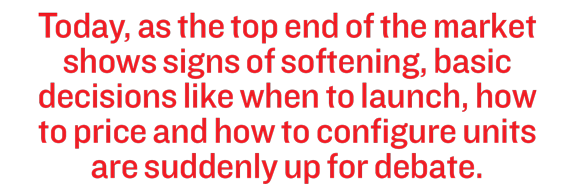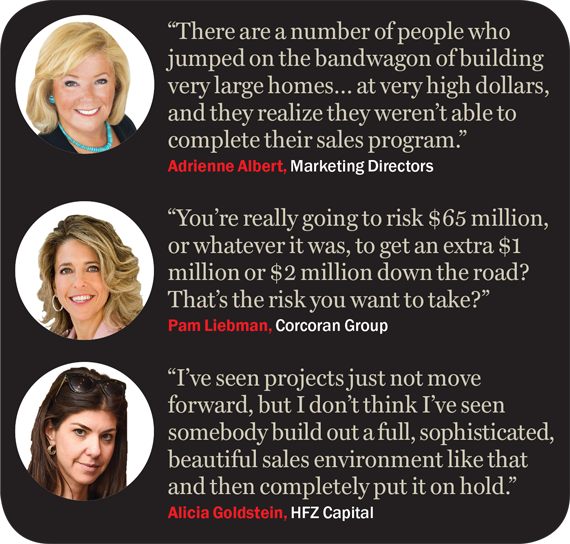A couple of years ago, Corcoran Group [TRDataCustom] CEO Pam Liebman tried to convince a developer to accept an offer for a penthouse that was a couple of million dollars shy of the asking price, which was north of $60 million. The developer refused: The building was still under construction, and he thought he could get more for the apartment once buyers could physically see it.
Liebman wasn’t as sure. “You’re really going to risk $65 million, or whatever it was, to get an extra $1 million or $2 million down the road?” she recalled saying to the unnamed developer during an interview last month. “That’s the risk you want to take?”
Fast-forward to today, and the unit is still sitting on the market — long after construction on the building wrapped up, Liebman said.
The incident speaks directly to the behind-the-scenes back-and-forth between developers and their advisors and what can go awry if a wrong choice is made. Today, as the top end of the market shows signs of softening amid a supply glut, basic decisions like when to launch, how to price and how to configure units are suddenly up for debate.
“There’s a tipping point between price and velocity. You need to find what that is for each project. And what’s successful for one project may not be for another,” said Alicia Goldstein, senior managing director and president of sales and marketing at HFZ Capital.
Developers are walking a fine line, largely because price cuts eat into their profit margins, which may already be thin given how much they paid for land, especially if they bought it within the last couple of years. But those cuts may be needed to generate traction in a market where pricier units are lingering longer than they were just last year. Indeed, residential properties priced at $4 million-plus sat on the market an average of 277 days during the first six months of the year — up from 232 days year over year, according to data from Olshan Realty.
Towers such as Extell’s One57 along with Macklowe Properties and CIM’s 432 Park Avenue have been sitting on the market since 2011 and 2013, respectively. While both saw early bursts of sales, that activity was followed by a slowdown that’s persisted over the past 18 months.
With every additional month a property sits on the market, the developer must shell out for carrying costs and interest payments. Some are even wondering whether the developers who didn’t leave themselves enough cushion room will make any money at all.
“A lot of developers don’t make money, particularly more inexperienced ones,” said Adrienne Albert of the Marketing Directors. “This is an extremely complex business. When you say ‘Oh, he’s making a fortune’ — well, he isn’t. He may just be breaking even.”
For new development marketers, there’s no catchall for determining strategy.
 Kelly Kennedy Mack, president of new development marketing giant Corcoran Sunshine, said success in this market is “highly nuanced.”
Kelly Kennedy Mack, president of new development marketing giant Corcoran Sunshine, said success in this market is “highly nuanced.”
“There can be a tendency to categorize various segments in blanket terms — to say that we’re seeing issues in an entire price point or neighborhood, or that the entire market is down,” she said. “In reality, supply-and-demand dynamics vary from block to block, and each building is, in a way, its own ecosystem in the current market.”
The waiting game
In a bid to best time the market, many New York City developers have been hitting the reset button on their marketing strategies.
One of the highest-profile examples is 111 West 57th Street, where JDS Development Group and Property Markets Group recently halted all public marketing and pushed sales back a year — closer to when the building will be ready for occupancy.
According to sources close to the developers, they believed that with so much competition they’d have a better chance at getting top dollar for the units when buyers could plan to move in, rather than having to wait three years. The developers are projecting a sellout of $1.45 billion for 65 apartments, according to the offering plan, which was approved by the New York attorney general last year.
“If the market were red-hot, people would be buying off plans, throwing checks down, and it’d be great,” PMG’s Kevin Maloney told Bloomberg News of the decision back in March. “But if you have a market where you think marketing would be ineffective for now, why would you launch and spend the money? Wait.”
The decision to delay sales came as a surprise to the industry, since JDS and PMG had already built a state-of-the-art duplex sales gallery complete with grand onyx-like bathtubs, dark wood kitchens and sweeping staircases.
“At that very high price point competing with the remaining inventory at One57, Baccarat and 432 Park, they probably felt they’d do better later in the cycle when they were further along,” HFZ’S Goldstein said, acknowledging the move was unusual.
“I’ve seen projects just not move forward, but I don’t think I’ve seen somebody build out a full, sophisticated, beautiful sales environment like that and then completely put it on hold,” she added.
But JDS and PMG aren’t the only companies changing course.
Simon Baron Development recently launched sales at its 29-unit condo building at 12 East 88th Street after abruptly pulling apartments there off the market in February. The pre-development units were listed in-house for only a month before the company hit the reset button, bringing in Douglas Elliman to consult on a complete redesign and reconfiguration of the units. The apartments were put back on the market last month with prices ranging from $1.5 million to over $16 million.
 Simon Baron did not immediately respond to a request for comment on why the firm opted to rework the building, though sources told TRD that the original property had not been received well by buyers. While going back to the drawing board may have cost the company more money than it originally projected, sources said it was a necessary risk.
Simon Baron did not immediately respond to a request for comment on why the firm opted to rework the building, though sources told TRD that the original property had not been received well by buyers. While going back to the drawing board may have cost the company more money than it originally projected, sources said it was a necessary risk.
“It’s not necessarily a relaunch as it is the introduction of a whole new product,” said Elliman’s Jared Seligman, who is working on the project. “We made significant changes, from the fixtures to the finishes to the elevator design.”
Developers at 432 Park and One57 are also getting in on the action.
In the face of slowing sales, Macklowe and CIM opted to divide full-floor apartments on five floors at 432 Park in an effort to create inventory at lower price points. And, at One57, Extell chief Gary Barnett abandoned plans to list 38 luxury rentals in the lower residential portion of the tower in favor of selling the units as lower-priced condos starting at $3.5 million. The developer has also been dropping prices for the full-floor units upstairs.
Meanwhile, at 10 Sullivan Street in Soho, developers PMG and Madison Equities chopped up the 8,400-square-foot penthouse into two smaller units — a 3,000-square-foot apartment asking $11 million and a 5,400-square-foot duplex asking $29.5 million.
And, at 160 Leroy Street, developer and hotelier Ian Schrager also opted to divide what would have been a 12,200-square-foot spread atop the building into two smaller units.
“There are a number of people who jumped on the bandwagon of building very large homes with the intent of selling at very high dollars, and they realize they weren’t able to complete their sales program,” the Marketing Directors’ Albert said. “The market wasn’t as vibrant as it was when they planned the project.”
At 432 Park, the move appears to be working. A flurry of units have closed in the last two months, including a $28 million deal for a three-bedroom condo bought by a member of the Mikati family of M1 Fashion fame.
“There is a lot of larger inventory on the market right now, so we are seeing developers in the early stages of planning that are shifting to smaller residences to capture a wider buyer pool,” Mack said.
She noted that it’s “much harder to divide larger apartments than it is to combine.”
“Our planning and design team is working continually with developers and their architects to premeditate for combinations down the road, should the pendulum shift significantly back to a need for larger residences,” Mack said.
Weighing risks
Developers opt for different strategies, of course, depending on price point and location.
Mack said with rental-to-condo conversions that target entry-level luxury buyers, there is often an expectation of a “rapid sales program.”
“Buyers at this price point are more price-conscious than other segments, often buying out of necessity, so developers may only push pricing so far,” she explained. “In contrast, an ultra-luxury tower costs more to build and takes much longer to build, so a developer may hold out for higher prices and plan for a more gradual sales program.”
For developers strategizing on how to sell out their projects most efficiently, timing can be everything. For companies such as JDS and PMG, that means weighing the downsides of selling into a crowded marketplace with the negatives of losing a year’s worth of marketing time. There’s also the risk of a development seeming stale if it’s on the market too long.
They also must balance their desire to get a head start on selling with the danger of launching too early. End-user buyers typically want to get into new homes right away, while investors are less concerned with occupancy dates. But sponsors can’t rely solely on investors.
“There’s a grey area in between where it’s not immediate occupancy but it’s also not investors looking for something way out,” Seligman said.
In some cases, it’s preferable to launch at the same time as your competition, said Jennifer Bocian, director of business development at the Brooklyn-based Ideal Properties Group.
“In most cases, it’s better to launch first, but we had one instance where we launched the same night as another project around the corner and it actually helped,” she said. “I think we were able to get more traction because people saw two for the price of one and made a night of it.”
Still, some said developers often fail to calculate the cost of additional marketing if sales activity falls short of expectations.
“The No. 1 mistake they make is saying ‘I can do it for less,’” Albert said. “People are optimistic, and they’re trying to make a deal look good to everybody involved. I’m more of a belt-and-suspenders person. If I’m wrong, that means there’s just that much more left at the end.”
Manhattan Investment Sales – November 1st 2015 to October 1st 2016 – 350+ transactions – $100
Manhattan Active Condominiums – November 1st 2011 to October 1st 2016 – 700+ transactions – $200
